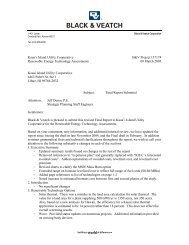Safer is Smarter - Kauai Island Utility Cooperative
Safer is Smarter - Kauai Island Utility Cooperative
Safer is Smarter - Kauai Island Utility Cooperative
You also want an ePaper? Increase the reach of your titles
YUMPU automatically turns print PDFs into web optimized ePapers that Google loves.
Photos by Shelley Paik<br />
KIUC’s electrical system has relatively low<br />
industrial customer loading. The highest peaks<br />
tend to be set by a combination of high tour<strong>is</strong>m<br />
and cloudy, light wind days, which cause loss of<br />
solar output for water heating and photovoltaic<br />
energy, while driving higher air conditioning use.<br />
Lately, daily peak demand has been between<br />
65,000 and 72,000 kilowatts (kW) due to mild<br />
conditions in both the local climate and economy.<br />
A recent day’s demand profile <strong>is</strong> shown in<br />
Figure 1, with kW demand along the vertical yax<strong>is</strong><br />
and time of day along the horizontal xax<strong>is</strong>.<br />
The last two highest alltime peaks were set<br />
during the week between Chr<strong>is</strong>tmas and New<br />
Year’s Day, 2004 and 2007. The December 27,<br />
2007, peak, shown in Figure 2, remains Kaua‘i’s<br />
alltime highest peak demand, at 77,750 kW.<br />
Theoretically, the entire load that resulted in<br />
the alltime high peak <strong>is</strong> still connected to the<br />
system—and perhaps even more has been<br />
connected—so KIUC could be required to serve<br />
that same demand, or more, once economic<br />
conditions improve.<br />
We know what causes the highest peak during a<br />
given year. If you look at the demand profiles in<br />
Figures 2 and 3, you will notice some similarities.<br />
When does daily peak occur? Unlike the<br />
mainland, which typically experiences its peak<br />
demand in the afternoon, Kaua‘i’s peak occurs<br />
within an hour after sunset.<br />
Think about it: What are you doing at that<br />
time? It <strong>is</strong> getting dark, and most people are<br />
heading inside, turning on lights, cooking dinner,<br />
bathing and watching TV. All the streetlights come<br />
on. The demand solar systems have been handling<br />
throughout the day <strong>is</strong> now placed back on<br />
conventional generators, with most of the burden<br />
being met by Port Allen. To ensure that burden <strong>is</strong><br />
met, every day the Port Allen crew attempts to<br />
maintain the balance of forecasted demand and<br />
required maintenance.<br />
Supply<br />
KIUC maintains a mix of conventional and<br />
hydroelectric generating units that have various<br />
pros and cons. Some units are very old, and some<br />
are new. Some are more efficient, and some less.<br />
Some are large, and some are small. Figure 3 l<strong>is</strong>ts<br />
each of the units and shows that KIUC has<br />
a total net generating capacity of about<br />
117,000 kW, which <strong>is</strong> enough to power roughly<br />
117,000 homes.<br />
<br />
<br />
<br />
<br />
<br />
<br />
<br />
<br />
<br />
<br />
<br />
<br />
<br />
<br />
<br />
<br />
Figure 1 – Demand profile from August 19, 2010.<br />
<br />
<br />
<br />
<br />
<br />
<br />
<br />
<br />
<br />
<br />
<br />
<br />
<br />
<br />
<br />
<br />
<br />
<br />
<br />
<br />
OCTOBER 2010 13
















